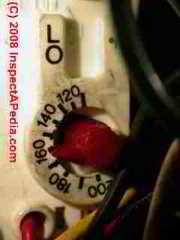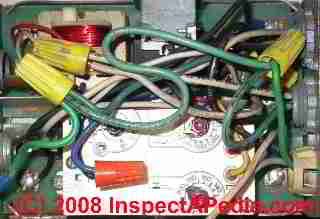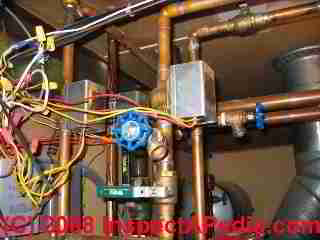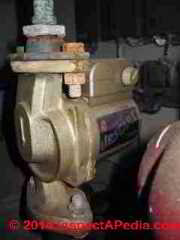 Circulator Pump Relays & Other Heating Circulator Pump Controls
Circulator Pump Relays & Other Heating Circulator Pump Controls
Circulator Relays Explained
- POST a QUESTION or COMMENT about heating circulator pump diagnosis & repair: what controls run the circulators? How should those controls be adjusted?
Heating system circulator pump troubleshooting: here we list & describe other heating system controls that manage or impact heating boiler circulator pump operation.
Troubleshooting & Repair Guide for hot water heating circulator pumps. How to tell if a heating circulator pump is working.
Why do some heating zones work and others not, why does heat come out of zones where thermostats are not calling for heat?
How to fix an air-bound heating system and blocked circulator pump. Where should a circulator pump be installed on a heating boiler? On the inlet or on the outlet side of the boiler?
This article series discusses Circulator Pumps: how to find, inspect, diagnose, and repair problems with Hot Water Heating System Circulator Pumps or circulator pump relay switches and controls.
InspectAPedia tolerates no conflicts of interest. We have no relationship with advertisers, products, or services discussed at this website.
- Daniel Friedman, Publisher/Editor/Author - See WHO ARE WE?
Circulator Pump Relays: 1 of 3 alternative ways to control hot water heat circulation

- The aquastat is the most common control of heating system boilers.
On a call for heat the thermostat, connected to the aquastat primary control, will operate a circulator control relay inside the aquastat to turn on the circulator pump, or on some systems the thermostat may be connected to a separate circulator relay discussed just below.
[Click to enlarge any image]
Our photo (left) shows the interior of a Honeywell R8182D aquastat primary control.
The gray rectangle at top center in this photo is the circulator relay.
You can just make out the red and white thermostat wires connected to the control at the upper left in this picture.
Our page top photo shows the low on a multi-function aquastat or primary control on a heating boiler. The low switch on an aquastat maintains temperature in a heating boiler that also makes hot water using a tankless coil.
The low switch indirectly controls the heating circulator by locking out (keeping off) the circulator pump assembly if the boiler temperature drops into the low range.
Detals are at AQUASTAT CONTROLS - home - Check valves control circulator flow or flow rate and may be used to balance heating zone flow or heat output.
Details are at CHECK VALVES, HEATING SYSTEM

- Circulator relays on heating boilers - an older and by some heating service technicians, a preferred method to control the distribution of heat to individual
building areas uses a individual circulator pump to force heating water through each individual heating zone piping.
This system too is usually found on hot water baseboard heating systems.
Our photo (above) shows a typical circulator relay with the control's cover removed - thermostat wires are connected at the upper left in this photograph. Line voltage is connected at lower left, and the circulator connections are at lower right.
This is a hydronic heating system circulator pump relay control with its cover removed. The basic components and connections in the circulator relay include:
- Green arrow: Line voltage in - 120VAC power to operate the circultor pump (white and black wires)
- Blue arrow: thermostat wires - low voltage circuit from thermostat that operates the circulator relay
- Yellow arrow: 24VAC transformer that operates switches and controls within the relay control assembly
- Red arrow: the circulator relay switch
Two or more circulator relay switches, one relay for each circulator pump, will be installed to turn on and off each heating water circulator if more than one heating circulator is installed.
Individual low-voltage thermostats located in the living area will respond to a call for heat by switching on the circulator relay which in turns on the (120V) circulator pump.
See RELAY CONTROL SWITCHES for details about how the circulator pump relay operates. - Individual High Limit and Low Limit relay switches On heating boilers: these may be provided on older heating boilers.
See LIMIT CONTROL, SINGLE - Protectorelays - on older heating boilers a protectorelay or stack relay may be used to control oil burner operation -
see STACK RELAY SWITCH

- Zone valves on heating boilers - heating water piping in a building, particularly where hot water baseboard heat is used, may be divided into separate heating zones (different floors, or different areas on a single floor) to
permit more detailed control of heat distribution in a building.
The control of heating water through these different heating zones may be accomplished by use of zone valves (one per heating zone or area or "loop" of heating piping) which in turn are connected to individual thermostats.
When the thermostat calls for heat in a particular building area, the thermostat switch causes the zone valve to open, to permit hot water to flow through that zone.
When the zone valve is fully open, an "end switch" inside the valve tells the heating system's circulator to begin operating, causing hot water to flow through the zone.
Typically heating systems using zone valves will have two or more zone valves (usually but not always located close to the heating boiler) and a single circulator pump (usually located on the return end of the hot water piping close to the heating boiler).
See ZONE VALVES, HEATING for details. - Air exit tanks on heating boilers and circulator pump mounting location - some heating boilers use an air exit tank mounted on the hot water header above the heating boiler to combine the function of
an EXPANSION TANK with
the AIR BLEEDER VALVE or air purge valve to rid the hydronic (hot water) heating system of un-wanted air.
Air in the heating system will often rise to a high loop of radiator or heating baseboard piping where it will block the flow of hot water, leading to an air-bound heating system and no heat in some or all of the heating system.
The air exit tank captures and vents unwanted air from its location above the heating boiler on the boiler outlet or supply side.
When an air exit tank is used instead of a simpler expansion tank at a heating boiler, the boiler manufacturer may specify that the circulator pump be mounted on the boiler outlet side to improve the function of this device. Thanks to Wayne Hoffman, technical advisor for Raypak, a Rheem company that provides hydronic heating equipment, for this detail.
Variable Speed Hot Water Heating Circulator Pumps, Motors & Controls
Shown above is a Bell & Gossett UpStart hot water heating zone circulator pump produced - a B&G product no longer distributed.
Controls for this circulator pump included a knob on the circulator that adjusted a variable-speed circulator motor to select one of speeds operated by a four-speed motor - the circulator output rate could be set by the consumer or heating service technician.
By changing the circulator motor speed we can slow or speed the flow rate of hot water through the zone managed by the circulator.
This provides another way to balance heat flow among multiple zones (and circulators) in a building.
This circulator, the Bell & Gossett SLC-25 Upstart Circulator was sold during the 1980's and is not currently available.
But B&G offered similar replacements (such as the NRF-22) and currently variable speed circulators are available from Taco and Grundfos.
At CIRCULATORS VARIABLE SPEED we describe these products and their controls.
...
Continue reading at CIRCULATOR PUMP WON'T START or select a topic from the closely-related articles below, or see the complete ARTICLE INDEX.
Or see CIRCULATOR PUMP RELAY FAQs - questions & answers about circulator relays posted originally on this page.
If you are not getting any heat at all out of a cold baseboard or radiator, see COLD HEATING RADIATOR REPAIR (hot water / hydronic heat)
If the heating boiler itself if does not turn on in a response to a call for heat see NO HEAT - BOILER.
Or see these
Hot Water (Hydronic) Heating Boiler Circulator Articles
- AIR BLEEDER VALVES
- AIR SCOOPS PURGERS SEPARATORS
- AIR-BOUND HEATING SYSTEMS
- ANTIFREEZE for BOILERS
- BOILER LEAKS CORROSION STAINS
- BOILERS, HEATING - home
- BOILER CONTROLS & SWITCHES
- CHECK VALVES, HEATING SYSTEM
- CIRCULATOR PUMPS & RELAYS
- BELL & GOSSETT B&G EQUIPMENT MANUALS & CONTACT
- CIRCULATOR PUMP BASICS
- WHAT GOES WRONG WITH HEATING CIRCULATORS?
- BYPASS a BAD CIRCULATOR
- CIRCULATOR COSTS
- CIRCULATOR NOISES
- CIRCULATOR OPERATION CHECKS
- CIRCULATOR PUMP LEAKS
- CIRCULATOR PUMP MANUALS
- CIRCULATOR PUMP MOTOR or BEARING FAILURE
- CIRCULATOR PUMP MOUNT LOCATIONS
- CIRCULATOR PUMP MOUNT POSITION
- CIRCULATOR PUMP RELAYS & OTHER CONTROLS
- CIRCULATOR PUMP RELAY CHATTERING
- CIRCULATOR PUMP WON'T START
- CIRCULATOR PUMP WON'T STOP RUNNING
- CIRCULATOR PUMP RUNS INTERMITTENTLY
- CIRCULATOR PUMP SPEED SELECTION & ADJUSTMENT
- CIRCULATORS VARIABLE SPEED
- MULTIPLE CIRCULATORS HOW TO HOOK UP
- MULTIPLE HEATING ZONE CONTROL
- TACO CIRCULATORS & CONTROLS
- WEAK HEAT, WEAK CIRCULATOR, TOO COOL
- CIRCULATOR PUMPS vs ZONE VALVES
Suggested citation for this web page
CIRCULATOR PUMP RELAYS & OTHER CONTROLS at InspectApedia.com - online encyclopedia of building & environmental inspection, testing, diagnosis, repair, & problem prevention advice.
Or see this
INDEX to RELATED ARTICLES: ARTICLE INDEX to HEATING BOILERS
Or use the SEARCH BOX found below to Ask a Question or Search InspectApedia
Ask a Question or Search InspectApedia
Try the search box just below, or if you prefer, post a question or comment in the Comments box below and we will respond promptly.
Search the InspectApedia website
Note: appearance of your Comment below may be delayed: if your comment contains an image, photograph, web link, or text that looks to the software as if it might be a web link, your posting will appear after it has been approved by a moderator. Apologies for the delay.
Only one image can be added per comment but you can post as many comments, and therefore images, as you like.
You will not receive a notification when a response to your question has been posted.
Please bookmark this page to make it easy for you to check back for our response.
Comments

IF above you see "Comment Form is loading comments..." then COMMENT BOX - countable.ca / bawkbox.com IS NOT WORKING.
In any case you are welcome to send an email directly to us at InspectApedia.com at editor@inspectApedia.com
We'll reply to you directly. Please help us help you by noting, in your email, the URL of the InspectApedia page where you wanted to comment.
Citations & References
In addition to any citations in the article above, a full list is available on request.
- Taco Inc., 1160 Cranston Street. Cranston, RI 02920 / (401) 942-8000 / Fax (401) 942-2360
Taco (Canada) Ltd., 8450 Lawson Road, Unit #3, Milton, Ontario L9T 0J8 / (905) 564-9422 / Fax (905) 564-9436, Website: www.taco-hvac.com, retrieved 1/25/2014, original source: http://www.taco-hvac.com/uploads/FileLibrary/100-101.pdf, quoting:
The Bumble Bee (model HEC-2) represents the very latest in variable speed wet rotor circulator technology. Its high efficiency ECM motor uses up to 85% less electricity than a standard circulator, and its out-of-the-box settings and 360 ̊ swivel flange makes it a breeze to install. Most importantly, the Bumble Bee’s Delta-T variable speed technology maximizes the overall efficiency of your heating system. - "Installation and Operation Instructions, Raytherm Residential Boilers," courtesy of Raypak®, and technical advisor Wayne Hoffman, personal communication 5/11/2009. Mr. Hoffman is a technical advisor with more than 30 years experience in the heating field. Raypak is a Rheem company that provides hydronic heating boilers for residential, pool, and commercial use. Raypak can be contacted at 866-583-0664 for technical support or for assistance in selecting the proper heating equipment for a specific application. Rheem Corporation is a manufacturer of water heaters and heating equipment including Ruud heating and cooling products.
- Our recommended books about building & mechanical systems design, inspection, problem diagnosis, and repair, and about indoor environment and IAQ testing, diagnosis, and cleanup are at the InspectAPedia Bookstore. Also see our Book Reviews - InspectAPedia.
- Domestic and Commercial Oil Burners, Charles H. Burkhardt, McGraw Hill Book Company, New York 3rd Ed 1969.
- National Fuel Gas Code (Z223.1) $16.00 and National Fuel Gas Code Handbook (Z223.2) $47.00 American Gas Association (A.G.A.), 1515 Wilson Boulevard, Arlington, VA 22209 also available from National Fire Protection Association, Batterymarch Park, Quincy, MA 02269. Fundamentals of Gas Appliance Venting and Ventilation, 1985, American Gas Association Laboratories, Engineering Services Department. American Gas Association, 1515 Wilson Boulevard, Arlington, VA 22209. Catalog #XHO585. Reprinted 1989.
- The Steam Book, 1984, Training and Education Department, Fluid Handling Division, ITT [probably out of print, possibly available from several home inspection supply companies] Fuel Oil and Oil Heat Magazine, October 1990, offers an update,
- Principles of Steam Heating, $13.25 includes postage. Fuel oil & Oil Heat Magazine, 389 Passaic Ave., Fairfield, NJ 07004.
- The Lost Art of Steam Heating, Dan Holohan, 516-579-3046 FAX
- Principles of Steam Heating, Dan Holohan, technical editor of Fuel Oil and Oil Heat magazine, 389 Passaic Ave., Fairfield, NJ 07004 ($12.+1.25 postage/handling).
- "Residential Steam Heating Systems", Instructional Technologies Institute, Inc., 145 "D" Grassy Plain St., Bethel, CT 06801 800/227-1663 [home inspection training material] 1987
- "Residential Hydronic (circulating hot water) Heating Systems", Instructional Technologies Institute, Inc., 145 "D" Grassy Plain St., Bethel, CT 06801 800/227-1663 [home inspection training material] 1987
- "Warm Air Heating Systems". Instructional Technologies Institute, Inc., 145 "D" Grassy Plain St., Bethel, CT 06801 800/227-1663 [home inspection training material] 1987
- Heating, Ventilating, and Air Conditioning Volume I, Heating Fundamentals,
- Boilers, Boiler Conversions, James E. Brumbaugh, ISBN 0-672-23389-4 (v. 1) Volume II, Oil, Gas, and Coal Burners, Controls, Ducts, Piping, Valves, James E. Brumbaugh, ISBN 0-672-23390-7 (v. 2) Volume III, Radiant Heating, Water Heaters, Ventilation, Air Conditioning, Heat Pumps, Air Cleaners, James E. Brumbaugh, ISBN 0-672-23383-5 (v. 3) or ISBN 0-672-23380-0 (set) Special Sales Director, Macmillan Publishing Co., 866 Third Ave., New York, NY 10022. Macmillan Publishing Co., NY
- Installation Guide for Residential Hydronic Heating Systems
- Installation Guide #200, The Hydronics Institute, 35 Russo Place, Berkeley Heights, NJ 07922
- In addition to citations & references found in this article, see the research citations given at the end of the related articles found at our suggested
CONTINUE READING or RECOMMENDED ARTICLES.
- Carson, Dunlop & Associates Ltd., 120 Carlton Street Suite 407, Toronto ON M5A 4K2. Tel: (416) 964-9415 1-800-268-7070 Email: info@carsondunlop.com. Alan Carson is a past president of ASHI, the American Society of Home Inspectors.
Thanks to Alan Carson and Bob Dunlop, for permission for InspectAPedia to use text excerpts from The HOME REFERENCE BOOK - the Encyclopedia of Homes and to use illustrations from The ILLUSTRATED HOME .
Carson Dunlop Associates provides extensive home inspection education and report writing material. In gratitude we provide links to tsome Carson Dunlop Associates products and services.


